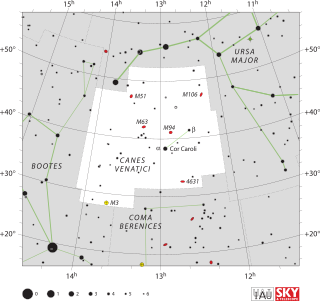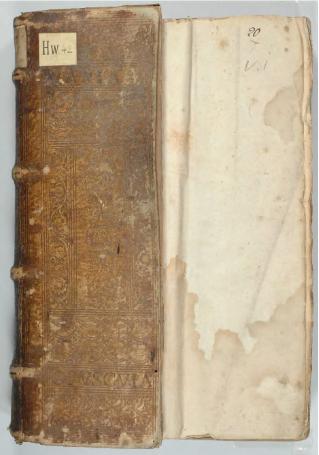
Canes Venatici is one of the 88 constellations designated by the International Astronomical Union (IAU). It is a small northern constellation that was created by Johannes Hevelius in the 17th century. Its name is Latin for 'hunting dogs', and the constellation is often depicted in illustrations as representing the dogs of Boötes the Herdsman, a neighboring constellation.

Hipparchus was a Greek astronomer, geographer, and mathematician. He is considered the founder of trigonometry, but is most famous for his incidental discovery of the precession of the equinoxes. Hipparchus was born in Nicaea, Bithynia, and probably died on the island of Rhodes, Greece. He is known to have been a working astronomer between 162 and 127 BC.

Abbé Nicolas-Louis de Lacaille, formerly sometimes spelled de la Caille, was a French astronomer and geodesist who named 14 out of the 88 constellations. From 1750 to 1754, he studied the sky at the Cape of Good Hope in present-day South Africa. Lacaille observed over 10,000 stars using just a half-inch refracting telescope.

Pisces is a constellation of the zodiac. Its vast bulk – and main asterism viewed in most European cultures per Greco-Roman antiquity as a distant pair of fishes connected by one cord each that join at an apex – are in the Northern celestial hemisphere. Its old astronomical symbol is (♓︎). Its name is Latin for "fishes". It is between Aquarius, of similar size, to the southwest and Aries, which is smaller, to the east. The ecliptic and the celestial equator intersect within this constellation and in Virgo. This means the sun passes directly overhead of the equator, on average, at approximately this point in the sky, at the March equinox.

Sextans is a minor equatorial constellation which was introduced in 1687 by Johannes Hevelius. Its name is Latin for the astronomical sextant, an instrument that Hevelius made frequent use of in his observations.

A star catalogue is an astronomical catalogue that lists stars. In astronomy, many stars are referred to simply by catalogue numbers. There are a great many different star catalogues which have been produced for different purposes over the years, and this article covers only some of the more frequently quoted ones. Star catalogues were compiled by many different ancient people, including the Babylonians, Greeks, Chinese, Persians, and Arabs. They were sometimes accompanied by a star chart for illustration. Most modern catalogues are available in electronic format and can be freely downloaded from space agencies' data centres. The largest is being compiled from the spacecraft Gaia and thus far has over a billion stars.

Triangulum is a small constellation in the northern sky. Its name is Latin for "triangle", derived from its three brightest stars, which form a long and narrow triangle. Known to the ancient Babylonians and Greeks, Triangulum was one of the 48 constellations listed by the 2nd century astronomer Ptolemy. The celestial cartographers Johann Bayer and John Flamsteed catalogued the constellation's stars, giving six of them Bayer designations.

The zodiac is a belt-shaped region of the sky that extends approximately 8° north and south of the ecliptic, which is the apparent path of the Sun across the celestial sphere over the course of the year. The orbital paths of the Moon and major planets are within the belt of the zodiac.

Scutum is a small constellation. Its name is Latin for shield, and it was originally named Scutum Sobiescianum by Johannes Hevelius in 1684. Located just south of the celestial equator, its four brightest stars form a narrow diamond shape. It is one of the 88 IAU designated constellations defined in 1922.

The Almagest is a 2nd-century Greek-language mathematical and astronomical treatise on the apparent motions of the stars and planetary paths, written by Claudius Ptolemy. One of the most influential scientific texts in history, it canonized a geocentric model of the Universe that was accepted for more than 1,200 years from its origin in Hellenistic Alexandria, in the medieval Byzantine and Islamic worlds, and in Western Europe through the Middle Ages and early Renaissance until Copernicus. It is also a key source of information about ancient Greek astronomy.

Sculptor is a small and faint constellation in the southern sky. It represents a sculptor. It was introduced by Nicolas Louis de Lacaille in the 18th century. He originally named it Apparatus Sculptoris, but the name was later shortened.

Leo Minor is a small and faint constellation in the northern celestial hemisphere. Its name is Latin for "the smaller lion", in contrast to Leo, the larger lion. It lies between the larger and more recognizable Ursa Major to the north and Leo to the south. Leo Minor was not regarded as a separate constellation by classical astronomers; it was designated by Johannes Hevelius in 1687.

Columba is a faint constellation designated in the late sixteenth century, remaining in official use, with its rigid limits set in the 20th century. Its name is Latin for dove. It takes up 1.31% of the southern celestial hemisphere and is just south of Canis Major and Lepus.

Johannes Hevelius was a councillor and mayor of Gdańsk (Danzig), in the Polish–Lithuanian Commonwealth. As an astronomer, he gained a reputation as "the founder of lunar topography", and described ten new constellations, seven of which are still used by astronomers.
ʿAbd al-Rahman al-Sufi was an iranian astronomer also known as ʿAbd ar-Rahman as-Sufi, ʿAbd al-Rahman Abu al-Husayn, ʿAbdul Rahman Sufi, or ʿAbdurrahman Sufi, historically, in the West as Azophi, Azophi Arabus, and Albuhassin. Al-Sufi published his famous Book of Fixed Stars in 964, which included both textual descriptions and pictures. Al-Biruni reports that his work on the ecliptic was carried out in Shiraz. He lived at the Buyid court in Isfahan.

Noctua was a constellation near the tail of Hydra in the southern celestial hemisphere, but is no longer recognized. It was introduced by Alexander Jamieson in his 1822 work, A Celestial Atlas, and appeared in a derived collection of illustrated cards, Urania's Mirror. Now designated Asterism a, the owl was composed of the stars 4 Librae and 54–57 Hydrae, which range from 4th to 6th magnitude.

A star chart is a celestial map of the night sky with astronomical objects laid out on a grid system. They are used to identify and locate constellations, stars, nebulae, galaxies, and planets. They have been used for human navigation since time immemorial. Note that a star chart differs from an astronomical catalog, which is a listing or tabulation of astronomical objects for a particular purpose. Tools utilizing a star chart include the astrolabe and planisphere.

Elisabeth Catherina Koopmann-Hevelius is considered one of the first female astronomers. Originally from Danzig, Poland, she contributed to improve the work and observations done together with her husband Johannes Hevelius.

Celestial cartography, uranography, astrography or star cartography is the aspect of astronomy and branch of cartography concerned with mapping stars, galaxies, and other astronomical objects on the celestial sphere. Measuring the position and light of charted objects requires a variety of instruments and techniques. These techniques have developed from angle measurements with quadrants and the unaided eye, through sextants combined with lenses for light magnification, up to current methods which include computer-automated space telescopes. Uranographers have historically produced planetary position tables, star tables, and star maps for use by both amateur and professional astronomers. More recently, computerized star maps have been compiled, and automated positioning of telescopes uses databases of stars and of other astronomical objects.

Xi Piscium (ξ Piscium) is an orange-hued binary star system in the zodiac constellation of Pisces. In 1690, the astronomer Johannes Hevelius in his Firmamentum Sobiescianum regarded the constellation Pisces as being composed of four subdivisions. Xi Piscium was considered to be part of the Linum Austrinum, the South Cord. The star is visible to the naked eye, having an apparent visual magnitude of 4.60. Based upon an annual parallax shift of 11.67 mas as seen from Earth, it is located about 280 light years from the Sun. It is moving away from the Sun, having a radial velocity of +26 km/s.


















